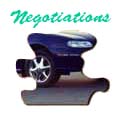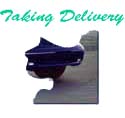
Since the birth of the automobile over 100 years ago, most people have been buying their new vehicles from a new car dealership. Patronizing remarks and intimidation techniques still exist in many dealerships, but they don’t have to ruin a good shopping excursion. With proper preparation and solid knowledge of the car buying process, you can take and maintain control during the dealership experience.
If you prefer not to negotiate with a dealer, there are other purchase options. Many dealerships offer no-haggle pricing with the firm cost of each vehicle plainly displayed on the window. Or you might choose to have a car buying service like Auto Advisor (1-800-326-1976) do the haggling for you. In every city in the country there are brokers who will handle the purchase for you. And now there are online services that will do the same.
Regardless of the method you use to buy a car, it’s important to realize that knowledge is power and preparation is everything. The “To Do” list that follows will more than adequately prepare you for a successful car buying experience. It involves some work, but remember, you are about to part with a tremendous number of hard-earned dollars and you’ll likely spend the next five to seven years with the car you choose. Besides, there is significant reward. Not only will you have the fun of test driving loads of different vehicles, you’ll end up with a great car selected just for you and your specific life-style.

In this special section (or book if you prefer) of New Car Buying Guide, you will be reading a series of articles designed specifically to lead you through the process of buying a new car. We recommend you read them in order. Where there are links to supporting information (like fuel economy ratings), click on them and see what is there. Bookmark this section and the links so you can find them easily whenever you need them.
You can always come back to them as you consider your car options. We have also provided a form you can print to keep you focused on what is important in a test drive.
We’ve heard for years from dealer nationwide that consumers who’ve read this guide are among the best informed shoppers they encounter. Dealers tell us, “We might as well cut right to the quick with this shopper – it will save us both time and money. She knows what she wants. She knows the price. She knows the deal.”
We encourage you to share your experiences with us and other New Car Buying Guide readers. Write us with questions (we’ll answer as many as we can) and also, tell us how you fared. Were you happy with the process? More empowered? Others can benefit from what you learned, also.

Now to get started get yourself a clean notebook (a steno pad or 3-ring binder works great too), label it “My Car,” and get on with the items on this “To Do” list. Follow the list diligently and make thorough notes. Following these procedures will provide you with a notebook filled with information that applies specifically to YOUR NEEDS. The process of acquiring this information and its written result not only helps you make an intelligent vehicle decision, it helps keep you on track in the emotional dealership environment:
The “TO DO” List
A. Write down all the cars you think you might like to own. While you could go a little crazy here and write down everything from a Lamborghini to a Silver Cloud Rolls Royce, you really need to give serious consideration to your life-style while making this list. What vehicles would fit your needs? Make life easier, more fun? List every car you can think of that you like.
This puzzle piece is about making an intelligent vehicle selection from the myriad of vehicles available today, it is important that you first match your life-style with a vehicle type that suits it best. Are you a fun-loving single? Choose a sports car, coupe, convertible. Do you have an active family? Maybe a sedan, minivan, wagon or crossover (mix of an sport utility vehicle and a sedan or wagon) is best for you.
Outdoor enthusiasts should look at a sport utility vehicle (SUV), pickup, sport wagon or perhaps a crossover vehicle. Do you have to carry loads of stuff? Consider a wagon, truck or SUV. There’s a vehicle today to meet EVERYBODY’S needs. Read “Vehicles and Their Categories.” It can help make your list of choices a comprehensive one.
B. Gather information from the Internet (or the library) about your car options. One of the most comprehensive lists of car options (also called vehicle comparison sets) exists right here on NewCarBuyingGuide.com. Every year we republish a list of all the vehicles on the market and what they compete against. Print magazines, like Consumer Reports and most of the automotive buff magazines, give a roster of new vehicle opportunities, including a short synopsis and price range for each vehicle listed. To read the New Car Buying Guide version read “Vehicles and Their Categories.”
C. Determine what you can afford to pay. Our chapter “What Can I Afford to Spend on a New Car?” will help you through this step. This is a very important assignment. Making a financial commitment to a car you can really afford is the smartest move you can make. (And we’ve heard countless stories of people who didn’t plan their finances well and ended up unable to pay for the vehicle.) You’ll be able to enjoy the car and never give your payment another thought. Remember, too, the added costs of owning a car like fuel, license, registration, repairs and accessories. This is also a good time to price insurance premiums for each of your car options.
D. Obtain the MSRP and dealer invoice price on the vehicles that interest you the most. This step will give you a realistic look at new vehicle pricing and help pare down your shopping list. An easy
place to get this pricing information is also here on New Car Buying Guide. Just click on the “New Car Prices” box that appears on every page in the upper right hand corner and follow the directions. While there, you can also request a quote from a dealership, if you are ready.
Remember, this is the information gathering stage. The knowledge you’re accumulating now will give you the power to have the upper hand in the negotiating step.
E. Decide whether you will lease or buy your new car. Leasing has grown in popularity by leaps and bounds in the recent past, mainly because of the high selling price of new cars. While it’s generally true that compared with conventional financing, a lease will have a lower monthly payment, you need to be aware of a leasing truism: the lower the monthly payment, the more likely extra charges may be lurking in the fine print. For all the details on this important financial decision, read “Lease or Buy: Deciding on Financing Options.”
F. Obtain a credit check and, if you choose, apply for online financing. Both can be done on the Internet right here from New Car Buying Guide. Several web sites make it easy to check your credit. You’ll find them right at the beginning of the section “Car Buying Help From The Internet.” While reading this article, also visit the finance companies page. This page will assist you in applying for online financing and that way you can see what you qualify for and what interest rate will apply.
G. Visit dealerships and test drive cars. From the list you made of vehicles best suited to your life-style and budget, find the dealerships in your area that handle those cars by visiting the New Car Buying Guide Inventory page. This page enables you to find dealerships in your area who carry the cars you want to test drive.
Personal recommendation is the best way to decide which dealerships have the best reputations. Ask people at work — or in your family. You can also call the local Automobile Dealer Association and inquire about which dealers have few, or no, complaints lodged against them.
It is important to separate test drives and price negotiations. They need to be two different efforts and should be done on separate visits to the dealership, or the negotiations should be done over the phone. For details on the test drive read “Test Drives and Dealerships: Evaluating New Cars.”
H. Negotiate your deal. Here is where the “knowledge is power” and “time is your friend” axioms holds forth and all your work begins to pay off. If you’ve performed Steps 1-7 faithfully, you will not be intimidated when the negotiations start. You will be prepared and in control. Our chapter on “Dealing with Dealers: Negotiating a New Car Purchase” offers help as you near the culmination of the car buying process. Once the deal is done, make a list of all the features and options agreed upon, including any “extras” the salesperson may have thrown in to sweeten the deal.
I. Take delivery. The car is nearly yours. Just a few things left to do, like taking an inventory of everything you purchased and checking it against the list you made in Step 8. Be sure the spare tire (and any other “removable item”) is in the vehicle and that the “prep” work actually happened. For details on this subject, see “Taking Delivery of Your New Car.”
The New Car Buying Guide has eight sections and three supplements. The first you are in the process of reading now. It outlines the process of new car buying. Next come five informative chapters that guide you through the intensive vehicle selection process, two helpful chapters designed to ensure a successful purchase experience, and three supplements providing tools and updates lists to aid the shopping process.

2. Which New Car Model is Right For Me?: Making the Intelligent Choice
By Joanne Brickman
For you to make an intelligent vehicle selection out of the myriad of vehicles available today, it is important that you first match your life-style with a vehicle type that suits it best.
Are you a fun-loving single? Choose a sports car, coupe, convertible. Do you have an active family? Maybe a minivan or a wagon is best for you. Outdoor enthusiasts should look at a sport utility vehicle or pickup. Do you have to carry loads of stuff? Consider a crossover, wagon, truck or SUV. There’s a vehicle today to meet EVERYBODY’S needs. Read “Vehicles and Their Categories.”
This “life-style to vehicle” exercise is critical if you want to be truly happy with the car you choose. Consider your present needs carefully and anticipate future life-style changes. Thoughtfully done, this appraisal of your life-style (present and future) as it applies to your transportation needs will help you buy a vehicle that is not only fun and useful today, it will be a car that can serve you well over the next several years.
After you’ve determined the type of vehicle best suited to your needs, more decisions need to be made. For one thing, you’ll need to make a judgment call on performance. An elementary, but serviceable, clue to anticipated performance of the car you’re considering is the horsepower rating. Several of today’s small vehicles generate only 90-horsepower and could give you a problem if you have a difficult freeway entry on your commute.
However, you probably don’t need the over 450-horsepower provided by the Dodge Viper. Although most studies say women give performance a lower ranking than men do, all agree that women rank this priority in the top five. Women’s number one priority is safety. Dependable performance affords safe passing on two-lane roads and a powerful vehicle can help avoid an accident wherever we may be driving.
Another decision concerns the priority put on comfort or luxury. If you travel long distances in your work or play, your vehicle really needs to be comfortable. A luxurious car is an impressive car and if that’s important to you, there are loads of plush vehicles to choose from. Read “Vehicles and Their Categories.”
A determination of features and options for your car is another thing you must attend to in order to do the new vehicle selection process thoroughly. Ask about the safety features of every car on your list. Does it have side airbags? Is there a cut-off switch for the passenger-side airbag of a vehicle with no back seat for a kid? Does it have an Antilock Brake System, power door locks and remote keyless entry?
Insist on a thorough discussion (better yet, do the investigation yourself as many salespeople don’t know all the features of the vehicles they sell) of just how safe this vehicle is for driver and passengers alike — especially third-row passengers.
Make sure you understand all the features in each vehicle you’re considering. Power doors, for example, can be confusing if you don’t get a demonstration of how they work. On most cars, the driver’s side door controls all door locks. But there are some unusual peculiarities to this feature, like the doors that automatically lock when the vehicle is put into gear, and unlock when it is taken out of gear. Although this feature may not be right for you, don’t count the vehicle out entirely just because of it. Many features can be disengaged, simply by removing a fuse. And now, most vehicles have computer screens where features like these are controlled.
Some features, or options, may be necessary for your life-style: superb sound system, pass-through trunk for skis or tall antiques, tilt steering wheel, power seats and fold flat seats, among many others. Review every one you can find, then list those important to you.
Many options come in packages. Carefully consider the cost and priority of the features in these packages. It could be more beneficial to combine packages rather than purchasing options a la carte. You’ll get complete help in making the intelligent car choice with this article.

3. What Can I Afford to Spend on a New Car?
By Mr. Ashly Knapp and Ms. Jean Swenson
From the moment you decide to buy a car, start thinking about your financial strengths and weakness, and financing options. Paying cash may not be the best way for you to go, even if it is comfortably affordable. Become acquainted with the different lease or loan payment possibilities and see how they can fit into your transportation budget. Explore creative ways of acquiring your vehicle. Develop a plan for all the costs of vehicle ownership.
Remember, the payment is not the only cost of owning a car. Some of the most important costs you need to remember, but many of us forget when buying a car, are the depreciation factor, financing costs, warranties, annual registration and anticipated expenses for repairs and maintenance. Scheduled maintenance servicing and intervals are detailed in your owner’s manual.
ALWAYS READ YOUR OWNER’S MANUAL IMMEDIATELY, THEN USE IT. The owner’s manual talks about not only how features are operated on the vehicle, but when and what types of maintenance the vehicle require. (People who spend three hours reading the manual to program their $200 DVD Player may never open the manual for the $40,000 car they just bought!) Knowing what you’ll need to spend to keep the vehicle in good running order should be a specific item in your personal budget. However you should also be prepared for unscheduled maintenance and repairs. Those costs cannot be accurately calculated, but should be expected.
Fuel is a major vehicle operating expense we sometimes ignore in the fervor of choosing a new car. There’s an EPA fuel economy rating noted at the bottom of the vehicle window sticker showing the MSRP (Manufacturer’s Suggested Retail Price.) Note that rating on every car you are considering or check with the Fuel Economy Guide that is available online. Be realistic about the miles you put on a car. Fewer miles driven just might allow you to buy that luxury coupe instead of the econo-box.
The issue with a car that gets too few miles to the gallon is both environmental and financial. If you drive a lot, that is 15,000 miles a year or more, what you spend on gas will definitely effect your overall budget. A low-miles-to-the-gallon, four-wheel-drive SUV will eat up your monthly gas budget quickly. Conversely, you may choose to purchase a better passenger car with high-miles-to-the-gallon. For example, a 15-mpg SUV driven 15,000 miles will cost $3,250 to gas up for a year (at $3.25 per gallon) and a 35-mpg passenger car will cost $1,400. The $1,400-difference could be used toward loan or lease payments on a better car.
Comparison shop for insurance, too. Check out possible savings like low-mile discounts or discounts offered for driver training courses, age, anti-theft devices. Don’t make a decision to buy any vehicle until, you check out the cost to insure it.
Taxes can be a big expense, particularly on costly cars. Presently the Internal Revenue Service has eliminated the luxury tax on automobile purchases over $36,000. However, this tax that could be reinstated. Check with your accountant or visit the Internal Revenue Service website to find out if it exists.
Listing budget considerations in your notebook, along with a priority of your wants and needs, will help further define “your car.” Your budget, and how much you’re willing to adjust it to accommodate the wheels you want/need, will determine how much your vehicle should cost.
4. Car Buying Help from the Internet
By Sandra Kinsler
Nowhere are changes in the approach to the car buying consumer more apparent than on the Internet. Daily, netizens become more and more aware of how they can use the Internet to help them with nearly every aspect of the new car buying experience from viewing all the models and features under consideration, to reading reviews, viewing crash test ratings, checking on theft likelihood and obtaining a Manufacturer’s Suggested Retail Price (MSRP).
Also available on the Web are dealer invoice prices, special incentives, make and model availability, probability and frequency of maintenance and much, much more. Never has there been more new car information available to the consumer, free of charge, 24 hours a day. You can use your computer to help you make your new car model decision and even to purchase the vehicle. There are dozens of helpful sites, including those belonging to nearly every automaker. This article will steer you to all the useful links available on the Web and tell you what you’ll find there.
5. Lease or Buy: Deciding on Financing Options
By Mr. Ashly Knapp and Ms. Jean Swenson
It is important that you carefully research and evaluate, based on your particular needs, the best way to finance your next automobile. What works best, a lease or a loan? Be aware that choices will need to be made based on your credit history, what you plan to buy and when you plan to buy. Start your finance shopping by using the Internet and the phone. Your goal is to discover the most beneficial way to get the money you need for the car you want. You’ll find that accomplishing the first steps is relatively easy, it’s the decision-making that’s hard. This article gives you the tools you need to move ahead intelligently. It helps you make decisions easier, and in the end you’ll know what’s best for you, your pocketbook and life-style.
6. Test Drives and Dealerships: Evaluating New Cars
By Joanne Brickman
Up to this point in the car buying process, you’ve been researching your options. Now it’s time for the hands-on evaluation of the cars on your option list based on the information you’ve acquired. In other words, it’s time to go to the dealership. This is where you see the car, feel the car and get a feeling for the dealership’s personality. Are these people you can work with to make selecting “your car” a smart choice?
These dealership shopping trips are critical to the information-gathering process of buying a car. It is during these expeditions that you gather brochures, determine if you like the exterior and interior styling and look at the window stickers on vehicles you think might be suitable, recording the vehicle’s price with, and without, optional equipment packages and other information in your notebook. This is also the time to test drive the cars, taking notes on comfort, handling and safety. Your notes should also include feelings and facts from your discussions with salespeople.
This dealership visit is a crucial element in the new car buying experience. It not only helps you select the right car for you, it also can be an important first step in the deal-making process.
The most important thing to keep in mind when visiting a dealership is “I am the one in control here.” If you don’t like the behavior of a salesperson, you can demand another. You can leave if they act badly or ask to speak to the manager. Remember that you are in control and you don’t tolerate bad behavior.
Also remember to keep the test drive visit separate from the buying (negotiation) process.
This article will tell you what to look for, how to evaluate a car, how to speak to a dealer and what to do during a test drive. We even provide a test drive form to help you keep track of the information on each car you are considering.
7. Dealing with Dealers: Negotiating a New Car Purchase
By Mr. Ashly Knapp and Ms. Jean Swenson
In this article, you’ll learn how to keep control of the negotiations, and how car sellers treat women of various ages and races differently than white males. You’ll also see how negotiation can actually be a comfortable and pleasant experience. You’ll enjoy learning and using our ten-minute automobile negotiation program which teaches that the interaction involved in the negotiation process is exciting and stimulating, and in the end, you win something. You’ll learn how to avoid uncomfortable confrontations and how to develop a good sense of when you are being strung along. You’ll get help minimizing and illuminating obstacles during negotiations.
Everyone negotiates and, in business, you don’t get what you deserve, you get what you negotiate. Buying a car is a business deal and this article will help you step yourself into unfamiliar territory by developing a new awareness of the negotiation process and a sense of self-esteem that will serve you well during the car transaction.
8. Taking Delivery of Your New Car
By Joanne Brickman
The dealing is over, but DO NOT take your new car “over the curb” and off the dealer’s lot until everything you and the dealer agreed to is checked off your list and you’ve read the contract closely once again. Pleasant as the dealer may seem (and in fact, most dealers are interested in treating you in such a manner that you will refer others to their showroom and come back yourself when you’re ready to buy again) during the selling process, legally, their obligation is over when you sign on the dotted line and drive the car off their lot.
This article discusses the activity known as “dealer prep” both as it applies to the vehicle and to you, the new owner. We’ve included a comprehensive checklist for you to use (in addition to your own) when taking delivery of “Your Car.”






